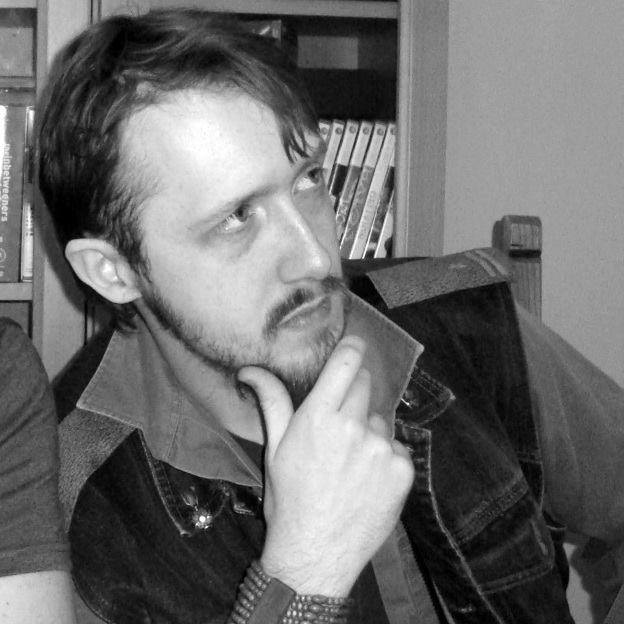We were delighted to welcome three keynote speakers to History of Games 2024. Each keynote speaker kicked off one day of the conference, offering key considerations of the current state of game studies that deal in some way with historical issues – be they industry, research, or development.
Dr Tom Apperley interrogated “Hugh Hefner’s “Homo Ludens””.
Dr Regina Seiwald presented “La Famiglia: The Mafia and Videogames”.
John Szczepaniak explored “Tracing forgotten family lineages through oral histories”.
View their abstracts and bios below!

Hugh Hefner’s “Homo Ludens”
This talk interrogates the legacy of Playboy magazine on contemporary digital games. Playboy offers insight into a historical, popular cultural notion of heteronormative masculinity in which play was significant, even paramount. Playboy cultivated an attitude towards play where the seemly mastery of play, playfulness, and the uncertainties and risks it entailed was portrayed as an essential facet of heterosexual, upwardly mobile, ‘tech-savvy,’ and implicitly white, masculinity. Play and leisure were conspicuously presented as sites of individual expression for women and men while inferring that strategic use of potential uncertainty and power imbalances by men made play and playfulness essential tools for the manipulation and seduction of women and the social dominance of others. The repercussions of Playboy’s construction of play are evident in game cultures in the undercurrents of gender-based harassment which impact women and the recurring contestation of the representation of women in digital games. This talk presents a historical engagement with these contemporary issues through the notions of asymmetrical play and topographical bodies. These notions highlight how the technologies, design, and promotion of digital games have indiscriminately adopted and appropriated the essentialist construction of masculinity and play proselytized by Playboy, demonstrating Hugh Hefner’s ongoing legacy on misogyny and sexism in contemporary game cultures.
Dr Tom Apperley

Tom Apperley is a Senior Research Fellow at the Centre of Excellence in Game Culture Studies and the Tampere Institute for Advanced Studies at Tampere University. He is a Docent in Media Studies at the University of Turku. He is the author of the open-access book Gaming Rhythms: Play and Counterplay from the Local to the Global (Institute of Network Cultures 2010) and is the author or co-author of more than seventy peer reviewed publications in the areas of digital games and cultures. His research focuses on the material cultures of gaming—the interfaces of digital games, and the platforms and infrastructures of gaming culture—in relation to issues of gender, sexuality, and inclusion.
La Famiglia: The Mafia and Videogames
Mafia games have been booming for decades now. Between the release of U.S. Gold’s The Godfather (1991) and games of the Grand Theft Auto series (1997–present), organised crime is a popular trope for game makers and players alike (Dainotto, 2015). We are drawn to these surrogate in-game families, which invite us to become part of them through their alluring system of favours and a strong sense of hierarchy, which offers you the world if you play by the rules but haunts you if you break them.
In her talk, Dr Regina Seiwald explores the relationship between the mafia and videogames from different perspectives. At the core of her research is the idea of the mafia’s organisation resembling familial structures, with a don leading as a patriarch and members taking on various roles. These family ties are underpinned by a strong sense of honour and loyalty. At the same time, this closed-off unit creates very specific relationships to external influences, such as the historical development of individual mafia strands, stereotyping the mafia gangster, socio-economic disparity in the past and present as well as racism and marginalisation (Lupetti, 2023).
The talk begins with a journey through time: The image of the Italian mafioso, which is arguably the most frequent strand of mafia we encounter in videogames in particular and popular media more broadly, is traced from a historical perspective. It will be argued that especially for American game makers, this representation can be linked to ideas of the American Dream. This image of the Italian mobster is subsequently mapped onto ludological and narratological representations in and characteristics of the mafia game genre, and its distinguished features are explored in various exemplary games, such as US Gold’s The Godfather (1991), EA’s The Godfather (2006), Mafia (2002), Mafia: Definitive Edition (2020), and Omerta: City of Gangsters (2013).
To counterbalance this focus on the Italian mafia, other strands of the mafia that often feature in videogames will also be addressed: the Japanese Yakuza, the Mexican La Eme, and the Russian Bratva. While they are all organised in familial structures akin to the ones that can be found in the Italian mafia, they attach different forms of honour codes to their hierarchical organisation. Furthermore, the kinds of crimes they are involved in and the status they have within the societies in which they operate are markedly different. This is also carried into the individual games centring on these branches of the mafia, and ludological and narratological peculiarities will be explored by looking at Yakuza: Like a Dragon (2005), games of the Grand Theft Auto (1997–present) series, Army of Two: The Devil’s Cartel (2013), Tom Clancy’s Ghost Recon Wildlands (2017), Hitman 2: Silent Assassin (2002), Hotline Miami (2012) and Hotline Miami 2: Wrong Number (2015).
Besides these – often glorious – in-game images of the gangster, who may justify their evil actions by emphasising the marginalisation they and generations before them experienced at the hands of authority, the real-life mafia is also intrinsically linked to games and gaming. Taking Grand Theft Auto Online as a case study, this talk concludes by stepping out of gameworlds and into reality by analysing how mafia gangs use online games to recruit drug mules for their criminal endeavours.
Dr Regina Seiwald

Dr Regina Seiwald is a Teaching Fellow in German and the Deputy Director of Languages for All at the University of Birmingham (UoB), UK. After gaining her MPhil.s in German Philology, English and American Studies, as well as General and Applied Linguistics in Innsbruck, Austria, she began her PhD on metafiction in contemporary British fiction at Birmingham City University (BCU) in 2014 and was awarded her PhD in 2018. Between 2019 and 2021, she held a postdoctoral fellowship at the Faculty of Media and English at BCU, where she researched Cold War narratives and paratexts in video games. Since 2023, she is a member of the EU-funded COST action Grassroots of Digital Europe: from Historic to Contemporary Cultures of Creative Computing (GRADE). She is the co-editor (with Ed Vollans) of (Not) In the Game: History, Paratexts, and Games (De Gruyter, 2023) and has published several journal articles and book chapters on narratology, Cold War narratives, paratextuality, and transmedia narration.
Tracing forgotten family lineages through oral histories
With commercial videogames being over half a century old, there now exist many great dynasties: long-running series, iconic characters, popular genres, hardware lines, even companies. You could argue the foundational cornerstones of the industry – arcades, computers, consoles, handhelds – each represents a “great house” in an epic, interconnected, dynastic struggle. Some lineages died off, such as Hudson, absorbed by Konami; others joined together, like Enix and Square; some things evolved, such as the text-adventure genre metamorphosing into point-and-clicks and then visual novels; others were reborn anew, such as the Wizardry series.
When examining videogame history, or engaging in its discussion, whether based around ludology or narratology, it is essential to understand the lines of influence which led to events. Rarely, if ever, are ideas immaculately conceived through pure inspiration. They don’t happen in a vacuum. Historians can research legacy documents from the time, such as newspapers; other archive materials, such as trade adverts or video clips; even the games and their code provide opportunities for archaeology (Aycock, 2014, Strung Out). This period-based material, however, will have been made with commercial considerations. In other words: curated at the time. Contemporary oral histories, meanwhile, afford greater freedom due to time having passed (Kishimoto, 2015, Untold History V2).
Of course, first-hand accounts have inherent risks: subjective bias, recall mistakes, and even false memories. Ed Logg once infamously said in interview that his game Xybots was influenced by Doom, despite predating it by six years (Jones, 2005, GamesTM #39). But as long as one remains cognisant of this, oral histories can provide an extremely valuable insight into the complex, multi-layered, and rich bouillabaisse that informs creative decisions. They often reveal interconnecting threads which would otherwise never be known.
This talk will explore examples and include first-hand recollections from those involved.
For example in Role-Playing Games made in Japan, developers today point to the influential genre progenitors of Yuji Horii, Tokihiro Naito, Yoshiyo Kiya, Henk Rogers, among others (interviewees, 2004, Family Computer 1983-1994). These veteran developers in turn cite obvious influences, such as Dungeons & Dragons, Wizardry, and Ultima (interviewees, 2014, Untold History trilogy). All well documented recollections, with multiple citations. But it gets interesting when talking with them, and they reference Alberto Manguel’s book The Dictionary of Imaginary Places (Kiya, 2018, Untold History V3), or the Tower of Druaga (Naito, 2015, Untold History V2), an arcade game based on Mesopotamian myths but originally sparked by Masanobu Endou watching Spielberg’s movie E.T. (Endou, 2015, Replaying Japan).
The DNA of inspiration sometimes comes from unexpected places. For example Ryuichi Nishizawa creating an early, almost Precambrian “infinite runner” with Wonder Boy, because he’d found an abandoned skateboard on his balcony (Kalata, 2014, Retro Gamer #124). His creation then branched off as the distinct Adventure Island series because, according to Takashi Takebe, Hudson wanted its own mascot character (Takebe, 2015, Untold History V2). Another relevant example is the Japanese First-Person Shooter, which formed in the early 1980s and existed in a Galapagos-style bubble; speaking to early pioneers of this genre from ASCII shows they were influenced by British microcomputers (Mitsuhashi, 2014, Untold History V1).
Speaking with veteran developers, despite faded memories, reveals influences which provide a framework for understanding the industry we have today and how games are made.
John Szczepaniak

Born in South Africa and of Polish descent, John Szczepaniak grew up in the UK and studied Japanese. He started documenting games in 2004, in issue 27 of GamesTM, writing about games from other countries. From there he would freelance for numerous places, including: Retro Gamer, Hardcore Gaming 101, Official PlayStation Magazine, Game Developer, and The Escapist. In 2006 he became staff writer on Retro Gamer, but after six months he moved to Practical Boat Owner magazine, published by Time Inc.
In 2013, through Kickstarter, John embarked on his most ambitious project: living in Japan for three months and interviewing over 80 people, to produce The Untold History of Japanese Game Developers trilogy of books. It took five years to complete, and afterwards would be condensed into Japansoft, published by Thames & Hudson. It has since been translated and published in France, Russia, and China.
After 20 years documenting the industry John has interviewed over 150 people. He’s also given academic talks in Canada and Germany.
Fun fact: John is licensed by the UK’s Royal Yachting Association as a Day Skipper!